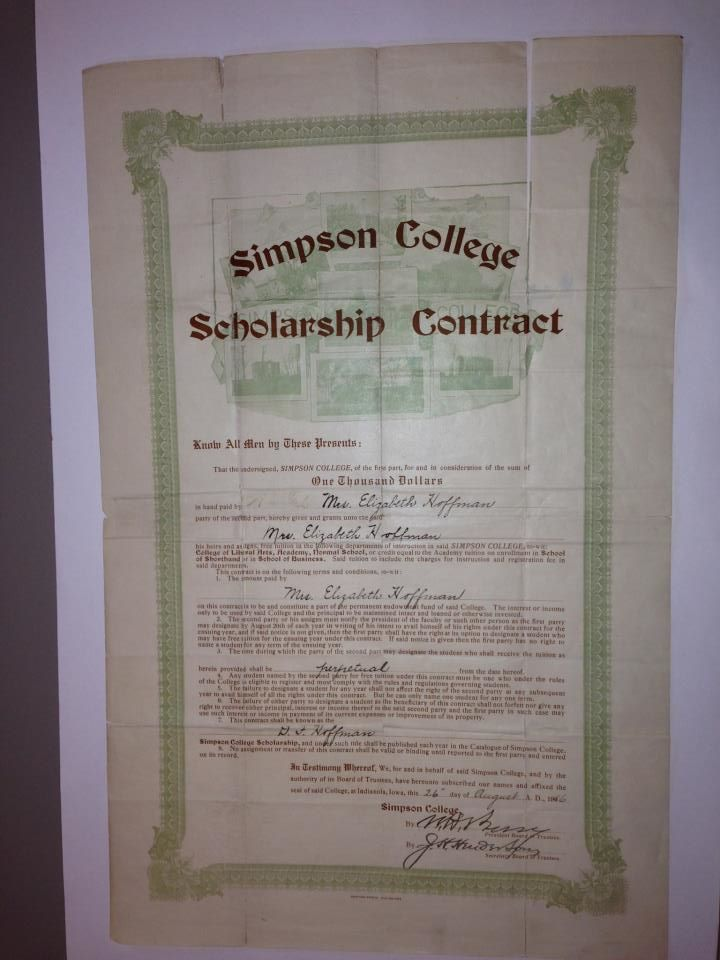Phi Theta Kappa is the international honor society for students in two-year college programs. Eligible members can be enrolled in programs at community and junior colleges or in Associate’s programs at four-year institutions. Patterned on the four-year senior honor society, Phi Beta Kappa, Phi Theta Kappa has its roots in Missouri and specifically at eight junior colleges for women. Only one of those first eight chapters is still in existence; it is the Epsilon chapter at Cottey College in Nevada, Missouri. Cottey College* is the only college for women owned by women (the P.E.O. Sisterhood, a Philanthropic, Education Organization, oversees the college).
The idea for Phi Theta Kappa came out of an organization, Kappa Phi Omicron, founded by six charter members in 1910 at Stephens College in Columbia, Missouri. Similar honorary groups sprang up on the two-year campuses across Missouri. When, in 1918, the presidents of Missouri junior colleges for women met they took on the task of creating a new organization that would honor the outstanding students at these two-year women’s colleges. In the early 1900s, a four-year degree was not necessary to teach and a good many of the women who attended these institutions became teachers. November 19, 1918 is the day the organization was founded; today the date is celebrated as Founders’ Day. Phi Theta Kappa was incorporated in the state of Missouri on April 29, 1920.
The first eight chapters were: Alpha chapter, Hardin College, Mexico, Missouri; Beta chapter, Stephens College, Columbia, Missouri – it became Alpha chapter when Hardin College became a four-year institution; Gamma chapter, Christian Female College, Columbia, Missouri; Delta, Howard Payne Junior College, Fayette, Missouri; Epsilon Chapter, Cottey College, Nevada, Missouri; Zeta chapter, Lindenwood Female College, St. Charles, Missouri; Eta chapter, William Woods College, Fulton, Missouri; and Theta chapter, Central Female College, Lexington, Missouri. Seven of these eight institutions either closed or became four-year institutions.
The Cottey College chapter submitted the Phi Theta Kappa song, which starts with the words “Give Us Wisdom.” It was adopted in 1923 and remains the organization’s official song.
In 1924, Phi Theta Kappa’s constitution was amended to include all two-year colleges bringing into the fold those that were all male and co-educational. In 1929, the American Association of Junior Colleges (now the American Association of Community Colleges), an organization formed in 1921, recognized Phi Theta Kappa as the official honor society of two-year institutions.
The first chapter charted outside of the United States was founded in 1987 at the University of Maryland’s Mannheim campus in Germany. A year later, when the Alpha Xi Beta chapter was founded at Clark County Community College (today known as the College of Southern Nevada), it marked the first time there was a chapter in all 50 United States. The first Canadian chapter was installed in 1991 at Medicine Hat College in Alberta, Canada.
In 2006, the membership roll of Phi Theta Kappa reached two million. Phi Theta Kappa chapters are located around the world including the United States, Canada, Germany, British Virgin Islands, the Republic of Palau, the Republic of the Marshall Islands, the Federated States of Micronesia and the United Arab Emirates.
The opportunity to apply for an array of scholarships totaling $37 million to be used for further study is one of the benefits of membership. In 2007, CollegeFish.org debuted. It is a web-based transfer and educational platform for community college students. Phi Theta Kappa powers it.
In 2011, the first chapter of the International Society of Baccalaureate Scholars (ISBS) was chartered at Florida’s Broward College. ISBS recognizes the accomplishments of top-ranked upperclassmen pursuing baccalaureate degrees at community colleges.
While once students had to wait until graduation to be inducted as members, today first-year students are eligible for Phi Theta Kappa membership. There are more than 1250 chapters and about 100,000 students become members each year.
* For more information on Cottey College, please see http://wp.me/p20I1i-h3
To read more about the history of the Illinois State Chapter of P.E.O. visit the link to the page about it and Lulu Corkhill Williams http://wp.me/P20I1i-Qf .
© Fran Becque, www.fraternityhistory.com












